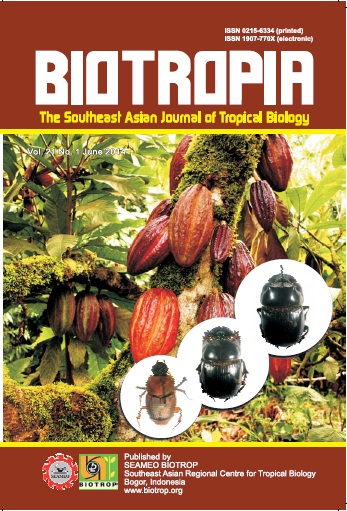
Tags
Effectiveness of Dung Beetles as Bioindicators of Environmental Changes in Land-use Gradient in Sulawesi, Indonesia
Content Language : English

Bioindicators have been widely accepted as useful tools for monitoring and detecting changes in the environment or habitat condition. By using bioindicators, it is possible to assess the impact of human activities on the biota, instead of examining the entire biota. In this paper we analyzed diversity of dung beetles (Coleoptera: Scarabaeidae) across land use gradient in
Central Sulawesi and tested the suitability of dung beetles as bioindicators for environmental changes. Ninety baited pitfall trapswere placed and several habitat parameterswere measured at five land-use types ranging from natural forest to cacao agroforestry systems to open areas in 2009 and 2012. The effectiveness of dung beetles as bioindicators of environmental changes was evaluated by the IndVal method, a method combining the specificity and fidelity of certain species with particular types of habitat or environmental conditions. Surprisingly, the results showed that the diversity of dung beetles in two types of cacao plantations were similar to the forest sites and were significantly higher than the open cultivated area. Of the 16 dung beetles species analyzed only four species could be suggested as indicator (characteristic) species while the majority of collected species were categorized as detector species. Two of them (Copris saundersi and Onthophagus forsteni) were associated with natural forest and cacao agroforestry system, thus were suggested as the indicator of shaded and cooler habitats whereas O. limbatus and O. trituber can be suggested as indicator of unshaded and warmer habitats (bare land area)
Link

This work is licensed under a Creative Commons Attribution-NonCommercial-NoDerivatives 4.0 International License.
